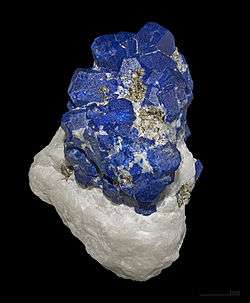Lazurite
| Lazurite | |
|---|---|
|
Lazurite, Ladjuar Medam (Lajur Madan; Lapis-lazuli Mine), Sar-e-Sang District, Koksha Valley (Kokscha; Kokcha), Badakhshan (Badakshan; Badahsan) Province, Afghanistan | |
| General | |
| Category | Tectosilicate |
| Formula (repeating unit) | (Na,Ca)8[(S,Cl,SO4,OH)2|(Al6Si6O24)] |
| Strunz classification | 9.FB.10 |
| Crystal system | Isometric |
| Crystal class |
Hextetrahedral (43m) H-M symbol: (4 3m) |
| Space group | P43m |
| Unit cell | a = 9.09 Å; Z = 2 |
| Identification | |
| Color | Deep blue, azure, violet-blue, greenish blue |
| Crystal habit | Crystals occur as dodecahedra, or rarely cubes; granular, disseminated, or massive |
| Cleavage | Imperfect on {110} |
| Fracture | Uneven |
| Tenacity | Brittle |
| Mohs scale hardness | 5–5.5 |
| Luster | Vitreous |
| Diaphaneity | Translucent to opaque |
| Specific gravity | 2.38–2.45 |
| Optical properties | Isotropic; anomalously anisotropic |
| Refractive index | 1.502–1.522 |
| Fusibility | 3.5 |
| Solubility | Soluble in HCl |
| References | [1][2][3][4][5] |
Lazurite is a tectosilicate mineral with sulfate, sulfur and chloride with formula: (Na,Ca)8[(S,Cl,SO4,OH)2|(Al6Si6O24)]. It is a feldspathoid and a member of the sodalite group. Lazurite crystallizes in the isometric system although well formed crystals are rare. It is usually massive and forms the bulk of the gemstone lapis lazuli.
Lazurite is a deep blue to greenish blue. The colour is due to the presence of S−
3 anions.[6] It has a Mohs hardness of 5.0 to 5.5 and a specific gravity of 2.4. It is translucent with a refractive index of 1.50. It is fusible at 3.5 and soluble in HCl. It commonly contains or is associated with grains of pyrite.
Lazurite is a product of contact metamorphism of limestone and typically is associated with calcite, pyrite, diopside, humite, forsterite, hauyne and muscovite.[1]
Other blue minerals such as the carbonate azurite and the phosphate lazulite may be confused with lazurite, but are easily distinguished with careful examination. Lazurite at one time was used as a synonym for azurite.[4]
Lazurite was first described in 1890 for an occurrence in the Sar-e-Sang District, Koksha Valley, Badakhshan Province, Afghanistan.[2] It has been mined for over 6,000 years in the lapis lazuli district of Badakhshan, Afghanistan. It has been used as a pigment in painting and cloth dyeing since at least the sixth or seventh century CE.[7] It is also mined at Lake Baikal in Siberia; Mount Vesuvius; Burma; Canada; and the United States.[7] The name is from the Persian lazward for blue.[3]
Structural issues
Lazurite and hauyne seem to have the same structure and both are sulfate-dominant minerals.[8] Lazurite is a pigment (so opalescent) and has a bright blue streak (especially as a component of the semi-precious stone lapis lazuli). Many hauynes have a white/ pale blue streak and are translucent. The difference might be a consequence of the redox state (sulfate/ sulfide ratio).[6][9]
See also
| Wikimedia Commons has media related to Lazurite. |
References
- 1 2 Handbook of Mineralogy
- 1 2 Mindat with location data
- 1 2 Webmineral data
- 1 2 Hurlbut, Cornelius S. and Klein, Cornelis, 1985, Manual of Mineralogy, 20th ed., Wiley, p. 459 ISBN 0-471-80580-7
- ↑ Mineralogical Society of America
- 1 2 Tauson V L, Sapozhnikov A N (2003). "On the nature of lazurite coloring" (PDF). Zapiski Vserossijskogo Mineralogicheskogo Obshchestva (in Russian). 132 (5): 102–107.
- 1 2 Eastaugh, Nicholas et al., 2004, The pigment compendium : optical microscopy of historical pigments Oxford: Elsevier Butterworth-Heinemann, p. 219, ISBN 0-7506-4553-9
- ↑ Moore, T.P., Woodside, R. W. M. (2014). "The Sar-e-Sang Lapis Mines". Mineralogical Record. 45 (3): 281–336.
- ↑ Hettmann K, Wenzel T, Marks M, Markl G (2012). "The sulfur speciation in S-bearing minerals: New constraints by a combination of electron microprobe analysis and DFT calculations with special reference to sodalite-group minerals". American Mineralogist. 97: 1653–1661.
